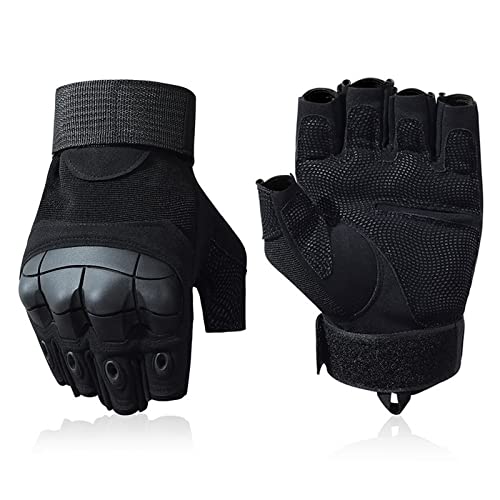You are using an out of date browser. It may not display this or other websites correctly.
You should upgrade or use an alternative browser.
You should upgrade or use an alternative browser.
New garage!
- Thread starter Shane
- Start date

Help Support Yamaha FJR Motorcycle Forum:
This site may earn a commission from merchant affiliate
links, including eBay, Amazon, and others.
Shane
Well-known member
wheres the electrician..... doing 220v in there ?!?!?
Hopefully your going overboard on the outlets.... Ya can never have enough of them.....

The electrician guys are doing the rough-in right now. Yes, 240 with both 30-amp and 50-amp service--two locations.
Seven 120 volt outlets around the walls, and one more on the ceiling for the door opener. The three on the north wall are placed for workbench, fridge, and air conditioner ease-of-access. The rest are for whatever else--vacuum, battery tenders, outside trimming, etc...
Shane
you got the A/C hole in place? just checking ?
Just measured the windows...should be ok! That's why there are outlets by each window...
Shane
Warpdrv
Well-known member
Good Man - way too many people just under think that whole strategy.....
You obviously are not one of "Those Guys"
You obviously are not one of "Those Guys"
Shane
Well-known member
Good Man - way too many people just under think that whole strategy.....
You obviously are not one of "Those Guys"
Thanks!
After having worked for 25 years out of inadequately-electrified shops, it is now my distinct pleasure to design (and pay for!) electricity the way it should be. I have always had to carefully husband what power was available, and occasionally running over capacity even when not trying to.
The owner of the electric company informed me that he supplied beefier-than-asked for wire and breakers, such that I can easily upgrade to a 70-amp 240 volt plug someday, if I want to. Just change out the plug! The ganged-together 40-amp breakers in the basement (that supply the sub-panel in the garage) verify this.
Shane
When I wired my garage, I put receptacles in the ceiling for the fluorescent shop lights. Makes it easier if I need to take one down to replace it or change out a ballast.wheres the electrician..... doing 220v in there ?!?!?
Hopefully your going overboard on the outlets.... Ya can never have enough of them.....

The electrician guys are doing the rough-in right now. Yes, 240 with both 30-amp and 50-amp service--two locations.
Seven 120 volt outlets around the walls, and one more on the ceiling for the door opener. The three on the north wall are placed for workbench, fridge, and air conditioner ease-of-access. The rest are for whatever else--vacuum, battery tenders, outside trimming, etc...
Shane
Shane
Shane
Well-known member
Window
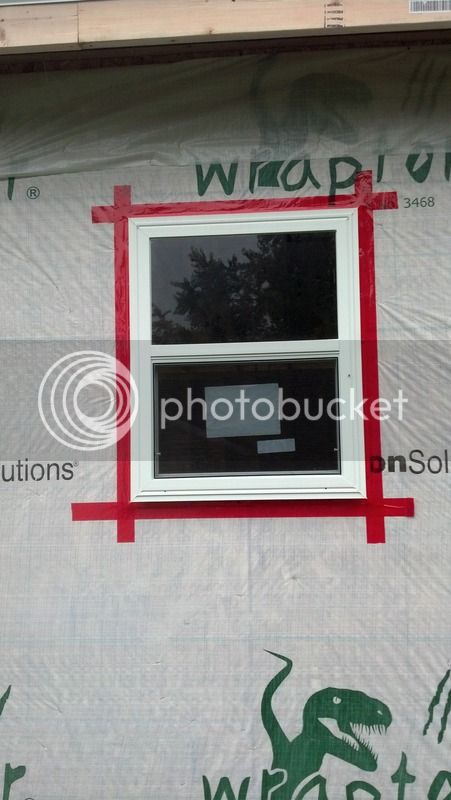
Other window
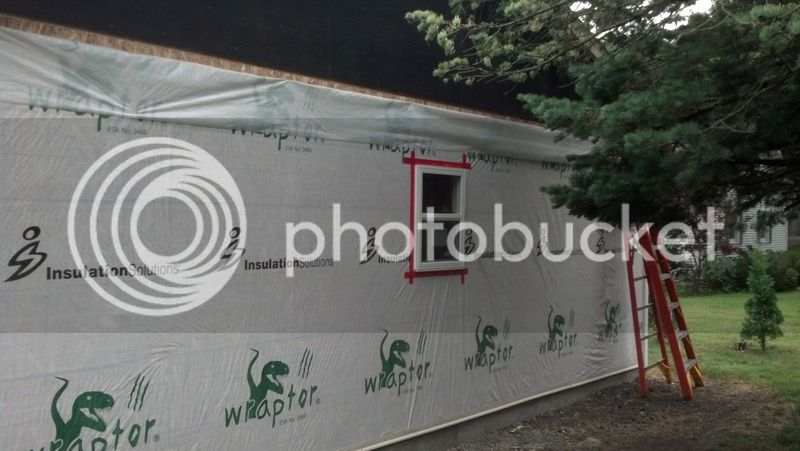
Almost done shingling. Note the scrap pieces to keep the ladder off the edge...
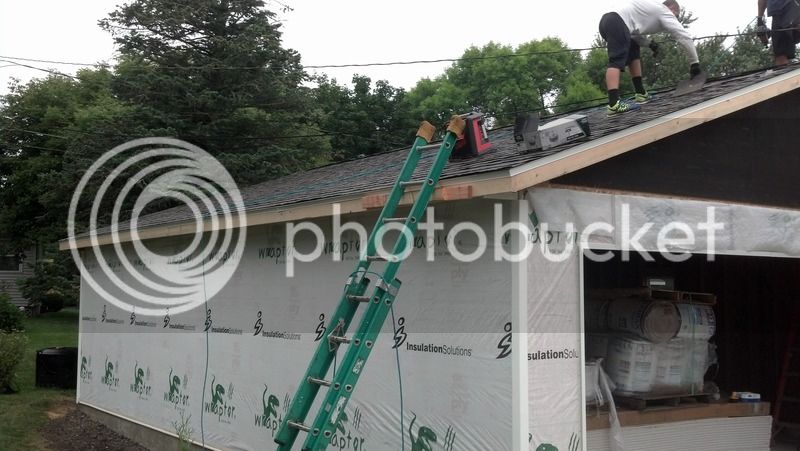
Panel and switch/outlets roughed in. The black one on the bottom left is the 50-amp 240 volt supply.

So, I mentioned that I planned to install a ceiling fan or two after the construction was done. They said "Well, why don't we just install ceiling fan boxes where you want them to go?" Here you can see one of them up close--the box straddles the truss rather than being nailed to the side of it. The supplied wood screws then hold the fan bracket right through the truss--no fan wobble, and much stronger than normal!
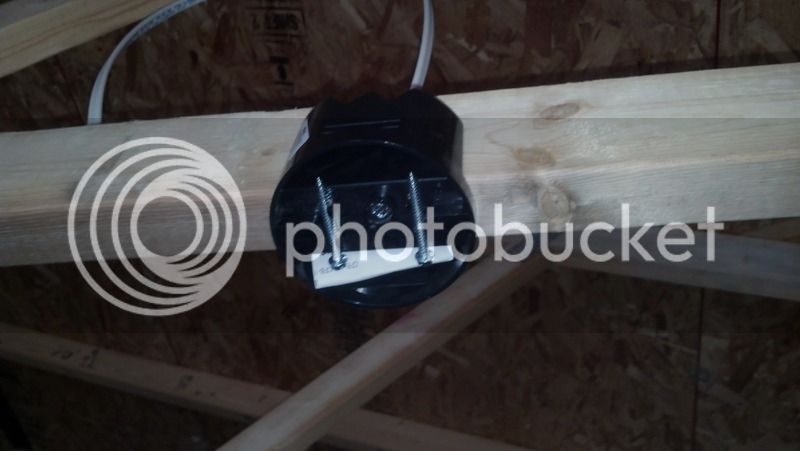
Last photo until probably Monday now...these two outlets will be at the left-hand end of my workbench. The blue is a normal 120 volt, and the black is a 30-amp, 240 volt supply. The 120 volt outlets are on two circuits, so if I blow one side at the workbench area, the other side of the garage (and the opener) will still work.
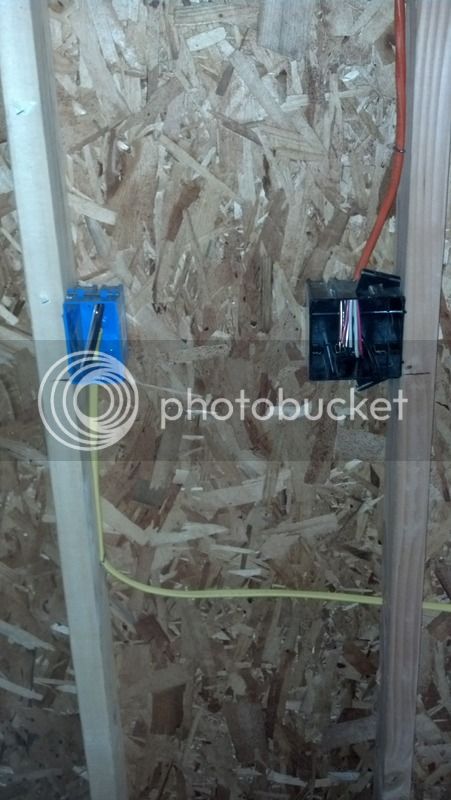
Shane

Other window

Almost done shingling. Note the scrap pieces to keep the ladder off the edge...

Panel and switch/outlets roughed in. The black one on the bottom left is the 50-amp 240 volt supply.

So, I mentioned that I planned to install a ceiling fan or two after the construction was done. They said "Well, why don't we just install ceiling fan boxes where you want them to go?" Here you can see one of them up close--the box straddles the truss rather than being nailed to the side of it. The supplied wood screws then hold the fan bracket right through the truss--no fan wobble, and much stronger than normal!

Last photo until probably Monday now...these two outlets will be at the left-hand end of my workbench. The blue is a normal 120 volt, and the black is a 30-amp, 240 volt supply. The 120 volt outlets are on two circuits, so if I blow one side at the workbench area, the other side of the garage (and the opener) will still work.

Shane

$24.37
Fuel Tank Sticker Motorcycle Stickers for Yam&aha FJR1300 FJR 1300 Tank Pad Protector Decal Emblem Side Fairing Symbol Adventure
nanyangshixianpushangmaohanggerenduzi

$91.99
Edwards Maintenance Kit fits 2003-2020 Yamaha FJR1300 Sport Touring
Edwards Motorsports & RV's

$14.39
$17.89
ROCKBROS Windproof Thermal Balaclava Ski Mask for Cycling, Running, Skiing - Men's and Women's
ROCKBROS USA

$159.99
FLAVOR Men Brown Leather Motorcycle Jacket with Removable Hood (Large (US standard), Brown)
FLAVOR Leather

$98.16
25-1775 Replacement for All Balls Wheel Bearing Kit (25-1775) for Yamaha FJR1300 03-16 FJR1300ES 14-18
Otisdelilah Auction

$64.99
Edwards Oil Change Kit fits 2003-2020 Yamaha FJR1300 Sport Touring
Edwards Motorsports & RV's
Auburn
Well-known member
Looks great!
Intech
Mr. Camping Meet
Good idea on the fan boxes. I have built three houses now (well, I had them built) and learned a lot each time. One of the things I specified was to install a fan box anywhere a ceiling fixture was being put in. Not much difference in price and saves a lot of hassle if you want to mount a fan in the future.
Great project! the only question I have is why you didn't install more windows for natural light?
Great project! the only question I have is why you didn't install more windows for natural light?
Warpdrv
Well-known member
You really only needed one fan...... Here ya go... 
Big Ass Fans.... ---- Just don't look at the price....

Big Ass Fans.... ---- Just don't look at the price....

Shane
Well-known member
Good idea on the fan boxes. I have built three houses now (well, I had them built) and learned a lot each time. One of the things I specified was to install a fan box anywhere a ceiling fixture was being put in. Not much difference in price and saves a lot of hassle if you want to mount a fan in the future.Great project! the only question I have is why you didn't install more windows for natural light?
Good question about the number of windows...
I don't have a real strategy about windows, other than to have some capacity for light and airflow. Probably could use more, but two is the number we stuck with, since that's how many were in the last one--which was the first garage I've had with any windows at all....
Shane
rushes
Well-known member
Fewer windows, fewer places for thieves peek or to get in. 
BTW, what kind of exterior siding will you be doing?
BTW, what kind of exterior siding will you be doing?
fjRaven
Well-known member
I might add, if you want to round out the man cave, maybe run a cable TV line out there to catch the games.
HotRodZilla
GOD BLESS AMERICA
Also, if you have an alarm for your house, run cable for your alarm to cover your garage also.
My buddy and I were talking about all the **** we have in our garages, and it adds up FAST.
My buddy and I were talking about all the **** we have in our garages, and it adds up FAST.
dcarver
Well-known member
for a mc forum, why is this now my favorite thread?
Shane
Well-known member
Fewer windows, fewer places for thieves peek or to get in.
BTW, what kind of exterior siding will you be doing?
Vinyl siding.
Shane
Well-known member
for a mc forum, why is this now my favorite thread?
Ha, ha! Thanks!
I think there is a very strong link between love of motorcycles and the garages that keep them warm and dry.
Shane
HotRodZilla
GOD BLESS AMERICA
There's no doubt about that. All my fun **** is in my garage. Except my safe, but if I had a secure place for that in my garage, or I lived in it, my safe would be there also. Haha...for a mc forum, why is this now my favorite thread?
Ha, ha! Thanks!
I think there is a very strong link between love of motorcycles and the garages that keep them warm and dry.
Shane
Barry keeps his sheep and blowup doll in his garage.
RaYzerman19
Go Wings!
FYI, I did the opposite in my new shop 2 years ago. Too many doors and windows, coulda used some more wall space for stuff.......... but, I woulda stuck a couple more windows in there depending on your interior layout........
PhilJet09
Nondescript FJR Hierarchy Displayed
Putting the exterior sheeting on before standing the wall up adds rigidity and keeps it square. You run the sheeting 1 1/2 lower than the bottom plate, so when you stand the wall up, you have a lip to flush it up to the sill plate with. It eliminates the awkwardness of trying to hold sheeting up nice and straight against the framing trying to get the first few nails in. The biggets downside of sheeting the wall first is that it's heavier and requires more people to stand it up. I've seen some folks compromise and only sheet each end, then stand the wall, then finish the sheathing in the middle.Did they nail on the OSB before they stood up the stud walls? That was a new one on me.
ionbeam
2 FUN
Hopefully there won't be splash-up onto the...You run the sheeting 1 1/2 lower than the bottom plate....
Similar threads
- Replies
- 18
- Views
- 3K
Motorcycle For Sale
SOLD - 2016 FJR 1300A - Ready to Go, Better than New - South Central PA 17350
- Replies
- 2
- Views
- 1K
- Replies
- 21
- Views
- 2K




































